Bonsai tree care is an extremely fulfilling hobby.
Learn everything about the right Bonsai tree care in this article as caring for Bonsais indoors is not an easy task!
Plus find our Bonsai Care Sheet to download at the end of this article.
Bonsai trees are mini trees full of life, despite their small stature.
Bonsai are originating in China but the art of Bonsai has been developed in Japan according to the Virginia State University.
The word “bonsai” means an ornamental shrub or mini tree.
Any mini tree you have to care for is a bonsai tree in the plant world.
Bonsai tree care
To care for a Bonsai tree use well-draining bonsai potting mix using akadama clay (sifted), lava rocks, and pumice and and bright direct light from a south-facing window. Water once the top 1-2” are almost dry (2.5-5cm). Provide a temperature between 65°F and 75°F (18°C – 24°C). Humidity needs to be 40-60%. Fertilize weekly using a bonsai tree fertilizer during the growing season.
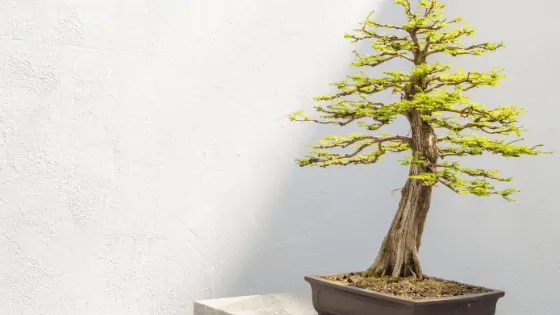
There are many different kinds of Bonsai trees
These little trees represent peace and harmony. We all can use a little of that in our lives, which is why they’re so popular.
But these trees aren’t as easy to care for as Mr.Miyagi from Karate Kid would have you believe.
It takes dedication and know-how to care for one of these magnificent bonsai trees.
One reason people don’t have success caring for a bonsai tree is that most types only thrive outside. They are trees, after all, small or not.
But there are a few small trees that can thrive inside too. Two of these bonsai trees include the Ficus Bonsai and the Fukien Tea.
You can even create a bonsai tree out of certain species of jade plants.
We’re learning all about bonsai tree care today so you can achieve tranquillity in your life. Plantophiles has you covered!
Table of Contents
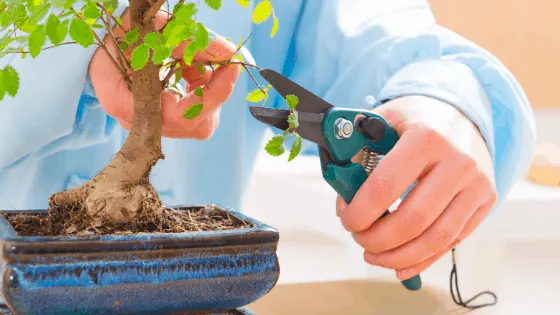
Bonsai Tree Care
Bonsai Tree Care Guide
Soil
For Bonsai Tree care use Bonsai potting soil using, akadama clay (sifted), lava rocks, and pumice.
Soil for a bonsai tree isn’t as simple as it appears. It’s something that beginners don’t take seriously. They end up with a dead tree before they even get started.
You must have the right soil for bonsai tree care. Please do not use regular potting soil for your tree. Normal potting soil doesn’t allow enough water to drain.
Bonsai trees need constant water drainage. The drainage holes in your pot won’t release the water fast enough to keep the tree from becoming saturated.
Without constant drainage, the roots will get wet feet. The wet feet will evolve into the roots rotting. But the soil still needs to hold onto enough water to keep the tree hydrated.
Aeration is another important factor for bonsai tree care. And if the soil is too compact, oxygen isn’t going to be able to find its’ way to the roots.
Air being able to penetrate the soil also helps the needed bacteria meet up with the mycorrhiza. This feeds into the hairs of the roots and travels to the leaves.
In other words, it’s the stepping stone for photosynthesis.
There is potting soil made for bonsai trees that you can buy. But you also have the option to make your own at home for cheaper.
There’s both organic and inorganic potting soil you can make. Organic potting soil uses ingredients like conifer bark and peat moss.
The inorganic soil includes ingredients like fired clay, lava rock, and organic compost.
My favorite bonsai tree soil mix includes:
- Akadama clay (sifted)
- Lava rocks
- Pumice
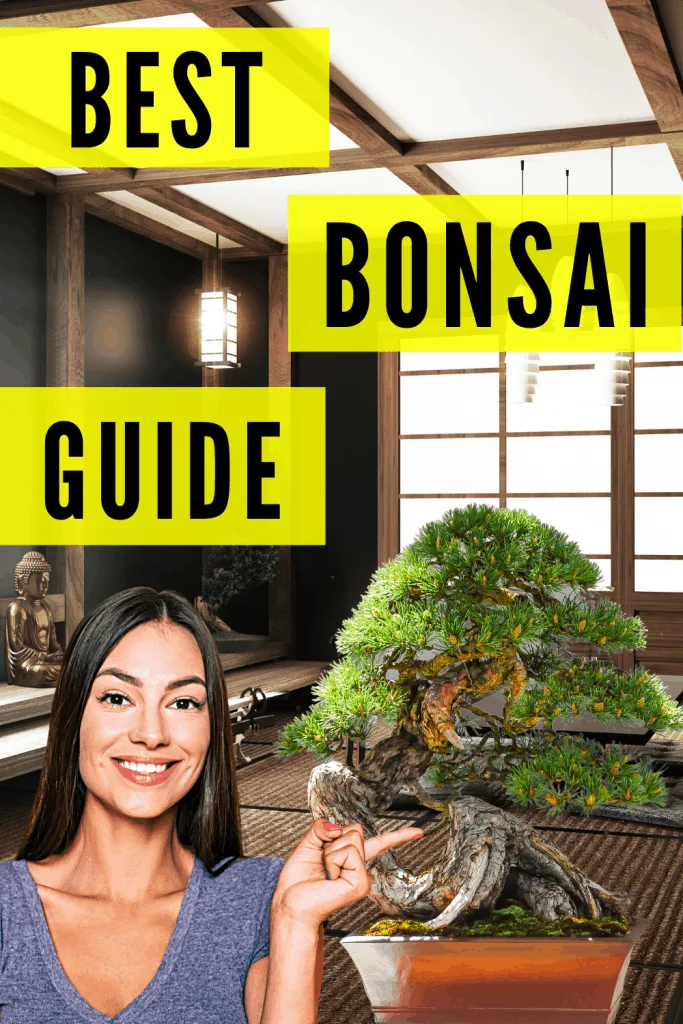
Bonsai Plant Care Best Guide
Light
For Bonsai tree care provide bright direct light preferably from a south-facing window or by using artificial grow lights.
Even an indoor bonsai tree needs a lot of intense light to thrive.
Without the right requirement of light, your tree is going to see slow growth. And a slow death.
Read our article about the right light levels for plants so you never place a plant again into the wrong spot.
You have two choices when it comes to light for your tree. Place it in a window, either west or south-facing.
If possible, a south-facing window so you know the sun is pouring down on your tree.
Believe it or not, but artificial light is your best choice. A window won’t always give the direct light your bonsai tree needs.
But you can adjust growth lights to make sure everything is perfect. We prefer to use HID (high-intensity discharge) lights for bonsai tree care.
The best HID lights to use are metal halide lights when you’re growing the tree. These lights boost growth. They have that intensity a bonsai tree needs.
Make sure there’s plenty of ventilation for the heat radiating down from the lights. They can get very hot and you want to prevent them from sucking all the moisture out of the soil and your tree.
Don’t buy discount LED lights though. They have a cooling system so you’ll never have to worry about your tree getting too much heat.
When using artificial lights, your bonsai tree needs between 10 and 12 hours of light a day.
Watering
Watering differs for each bonsai tree as does proper bonsai tree care. Each tree is unique and has its’ own needs. You must watch your tree to determine its’ needs.
Most bonsai trees are made up of at least 55% water. And the leaves of the tree are made up of at least 75% water.
To decide when to water your tree, stick your finger in the soil about 1-2” deep (2-3 centimeters). Check if the soil is dry or still moist.
Dry soil means it needs water.
Make sure not to let the soil get too dry before you water the tree. The roots need that hydration.
When you go to water the tree, make sure you use plenty of water.
The soil should be moist when you’re finished. Water the tree until water starts to drain out of the drainage holes.
That way you know that the roots are getting the water they need to keep the bonsai tree going.
The leaves also rely on water (and other nutrients) to absorb sunlight through the photosynthesis process.
But don’t water it if there’s still moisture.
Too much water can lead to wet feet for the roots. It can also lead to mold or mildew on your tree and the roots.
If your bonsai tree is under hot grow lights, you might need to water it every day for quality bonsai tree care.
Watch it and your tree will tell you when it needs watering.
Temperature
Bonsai trees need to be in a temperature between 65°F and 75°F (18°C – 24°C) to grow and thrive. At night, the temperature should be somewhere between 55°F and 60°F (13°C – 16°C).
The temperature for bonsai tree care is up there compared to many other house plants.
During the colder months, the temperature should run between 50°F to 70°F (10°C – 21°C).
The roots of a bonsai tree are sensitive to different temperatures. You need to prevent them from getting too dry in the hot months and too cold in the cold months.
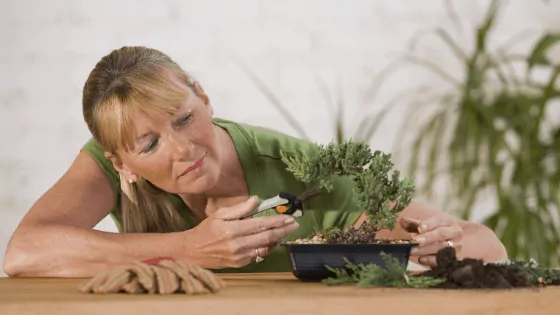
The right Bonsai tree care is essential for a happy plant
Humidity
For indoor bonsai tree care, you need high humidity. It has to be between 40% and 60% for a happy tree.
To get the amount of humidity that a bonsai tree needs, you’re going to need a humidity tray (or pebble tray). And you can make one of these trays at home with little effort.
You’ll need a tray that’s big enough to fit your bonsai tree and the pot. Fill it with pebbles.
The pebbles should be about an inch deep into the tray. Fill the tray with water and place the bonsai tree on top of the pebbles.
The water evaporates and creates humidity for the tree. When the water in the tray is gone, fill it up again.
Don’t forget to mist the tree a few times every day. Feel the leaves to decide when they need misting.
A moisture meter can help you out a lot with bonsai tree care. And they aren’t expensive at all. The meter runs on a scale of one to 10. One is desert dry and 10 is flooding.
Moisture meters allow you to see what the humidity of the tree is so you can take better care of it.
Fertilizer
Fertilize a bonsai tree weekly during the growing season in spring and summer using a bonsai tree fertilizer.
A normal tree can spread its’ roots underground. This lets the roots soak up all the nutrients that the earth has ready for them.
Inside bonsai trees aren’t able to spread their roots out in the same manner. They don’t have the same room.
But they need some of the same nutrients a normal-sized tree does.
For the best bonsai tree care, you need to fertilize your tree all year round.
It’s not exposed to the season changes. Read our nutrients and fertilizer guide if you want your bonsai to thrive!
You don’t need to fertilize older bonsai trees as much as you would a younger tree.
If your tree is not doing so well, bonsai tree care is important to get it back to thriving.
But you shouldn’t fertilize it despite your instincts. It can worsen the situation.
Propagation
You can use bonsai tree cuttings to propagate them. We have a step-by-step guide below to help you with this part of bonsai tree care.
Growth
A bonsai tree can grow up to 60 to 80 inches (152cm to 203cm) in height. And they can be as small as three inches in height (8cm).
The difference between the largest trees and the smallest trees are vast.
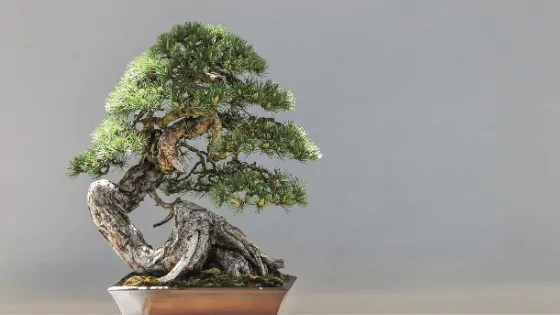
Bonsai means little tree
Potting
Another important part of bonsai tree care is potting or re-potting the tree. You should pot bonsai trees in the middle of summer for the best outcome.
When your tree’s roots can’t spread anymore, it’s time to move up to a bigger pot. On average, this is every two to three years. But always check the roots before you decide to re-pot your bonsai tree.
Always use fresh soil when you re-pot and don’t get too big of a pot. You don’t want your bonsai tree to stress out.
Bonsai Tree Propagation Steps
All you need to propagate a bonsai tree is fresh cuttings. It’s the easiest and the most common way to get another tree growing and certainly one of the most enjoyable parts of bonsai tree care.
You need to propagate in the warmer months, either in spring or summer.
- First, you need a few cuttings from your bonsai tree. You can do this next time you’re trimming and pruning your tree. Grooming your tree is a must for bonsai tree care. When you go to cut, the cutting needs to be four to six inches in length. There should be at least three nodes long or have three leaves. The bigger, the better. Don’t use scissors. You should always use clippers.
- Trim off the bottom leaf or leaves, towards the end up you trimmed. Then cut the bottom at a 45-degree angle. Use a twig shear for the best results. This makes the cuttings easier to set in the potting soil.
- Now you want to get your pot together. Lay your soil mix for bonsai trees on the bottom of the pot.
- Place the bottom of the cuttings in the soil at least an inch deep. Make sure it’s standing upright. If it won’t stand up by itself, try place a straw in the soil next to it and tie it to the cutting.
- You can use a plastic bag over the cuttings to trap in the moisture. It will increase the chances of the cuttings evolving into a new bonsai tree.
- It’s time to place the cuttings in a shady area so they can root. You have to water them when the soil is close to being dry, as you would if they were grown.
- Your bonsai tree cuttings should be rooted after about a month. To double-check, gently pull upward on the cutting. If it doesn’t want to come up, it’s rooted.
- Once your cuttings are rooted, remove the plastic covering. It’s done its job creating humidity. Mould and mildew can start if it stays on much longer. Your new bonsai tree needs ventilation now. Within three to five weeks, you’ll see growth in your tree or trees.
Varieties of the Bonsai Tree
The number of species of bonsai trees will blow your mind. This list is our absolute favourite bonsai trees.
Ficus benjamina
This is the most popular indoor bonsai tree. The bonsai tree care for this ficus is pretty easy. It’s a great tree for beginners. But they’re easy to injure and they take a long time to heal. They’ll start producing a milky sap from their wounds.
Serissa japonica
The Snow Rose cultivates beautiful flowers starting in early spring. There are tons of tiny little flowers blooming off of this bonsai tree.
Schefflera arboricola
These are nicknamed dwarf umbrella trees due to the way the leaves hang. They hang over, looking like an umbrella. It’s like it’s trying to perfect itself. The downside is the sap is very unhealthy for animals.
Common Problems with Bonsai Tree Care
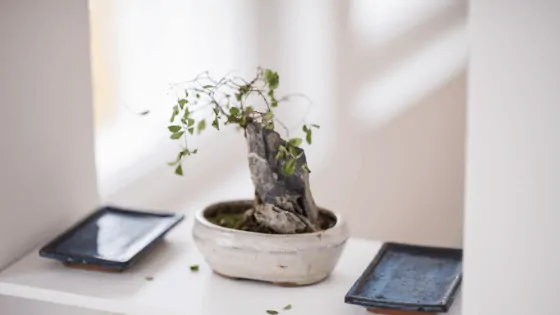
Bonsai Tree Problems
There are several types of pests you should be on the lookout for.
These pesky little creatures invade bonsai trees. And fighting these bugs is a part of your bonsai tree care.
Aphids are hard to see. They’re either green or yellow. They like to suck all the liquid nutrients in your bonsai tree.
They mate quickly. Very quickly.
And a large number of aphids can kill your tree. All those mouths are stealing your tree’s nutrients.
Your bonsai tree’s care needs to get rid of these insects right away.
Mealybugs will eat away the leaves on your tree. They hide under leaves and it can be hard to see if you’re not looking for them.
They’re a strange waxy white color. But don’t worry, they’re pretty easy to get rid of.
Another big insect to contend with is whiteflies. You’ll see these suckers sitting on the leaves of your bonsai tree. They suck away the important nutrients from the tree.
There are a handful of ways to get rid of insects in your bonsai tree.
One easy way is soapy water. It’s that simple. Use a cotton ball to wipe off the leaves of the tree. For some bugs, you’ll have to come back a week or two later to repeat.
A mix of isopropyl alcohol and water is another helpful bug killer to try out when the soapy water isn’t cutting it.
Tips for an Unhappy Bonsai Tree
There’s nothing worse than a sad bonsai tree. They’re meant to bring harmony and tranquillity.
They can’t do that if they’re withering away.
With the right bonsai tree care and love, you can correct most of these problems.
Your Bonsai Tree’s Leaves Have Coloured Spots
Spots on leaves can come in black, brown, and even red.
These spots mean your poor bonsai tree has a fungal infection.
Hydrogen peroxide is a great way to combat fungal infections.
Your Bonsai Tree’s Leaves are Dying
You have yellow and wilted dying leaves that are falling off your bonsai tree and you’re not sure what’s going on?
You might be over-watering your bonsai tree. Make sure the soil is dry before you water it. Try not to soak the soil too much when you do go to water.
Your Bonsai Tree Looks Swollen
A bonsai tree with swollen bark is a bit harder to remedy. It’s important to be careful when you are trimming and pruning your tree. This is not the easiest part of the bonsai tree care to be honest.
When it doesn’t heal after you’ve trimmed it, an infection can take over. These different infections hide underneath the bark.
As the infection gets worse, the more swollen the bonsai tree gets.
Frequently Asked Questions About Bonsai Tree Care
Why can’t I grow a nontropical bonsai tree inside?
Nontropical bonsai trees (or temperate trees) grow like the trees in your yard. They need all four seasons, including going dormant during the winter season.
What type of pot should I use for my indoor bonsai tree?
For indoor bonsai tree care, you can use the same pot you would use for other indoor plants.
But you do want to use a larger pot than you’d assume you need. This gives the tree’s roots room to spread out so it can get all those nutrients it needs.
How do I prune my bonsai tree?
Pruning for bonsai tree care is simple. It’s bonsai tree care 101. Don’t use scissors but instead use clippers.
Prune all dead and dying leaves with a quick snip. You can also get creative and shape it up.
Why is my inside bonsai tree dropping leaves?
Many inside bonsai trees go through the same motions during the colder months.
When the temperature drops, your bonsai tree’s older leaves are going to drop. This is so new leaves can out.
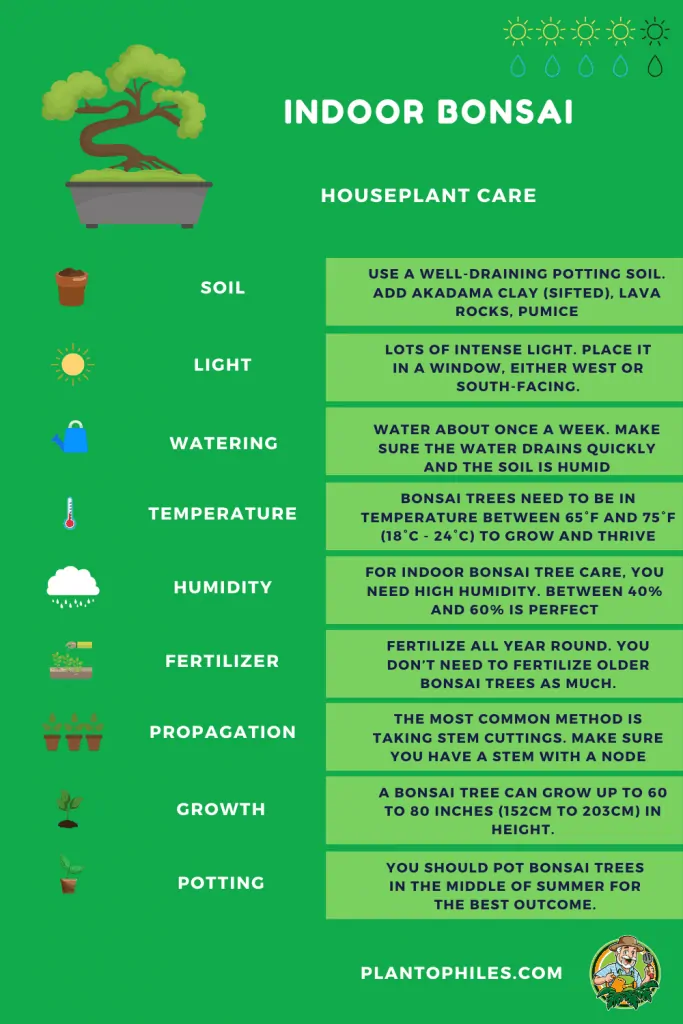
Bonsai Tree Care Sheet

Daniel has been a plant enthusiast for over 20 years. He owns hundreds of houseplants and prepares for the chili growing seasons yearly with great anticipation. His favorite plants are plant species in the Araceae family, such as Monstera, Philodendron, and Anthurium. He also loves gardening and is growing hot peppers, tomatoes, and many more vegetables.


